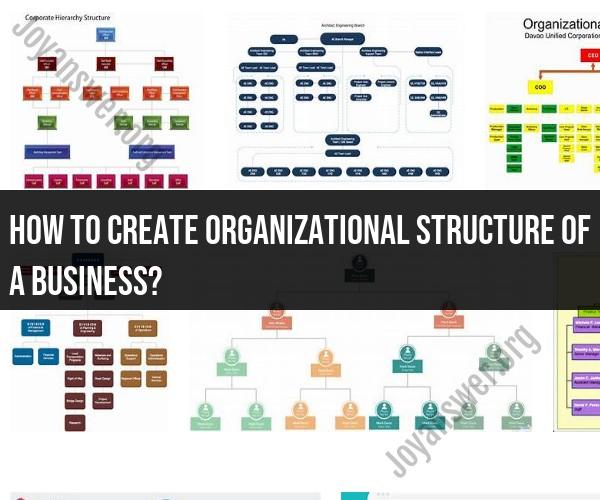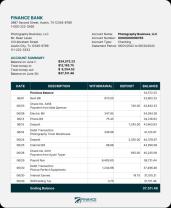How to create organizational structure of a business?
Creating the organizational structure of your business involves designing a framework that defines roles, responsibilities, and relationships within your company. A well-defined organizational structure helps employees understand their roles and reporting lines, facilitates communication, and supports efficient operations. Here's a step-by-step guide to help you create the organizational structure for your business:
1. Define Your Business Goals and Strategy:
- Before you can design your organizational structure, clarify your business's mission, vision, goals, and overall strategy. Your structure should align with your strategic objectives.
2. Determine Your Business Needs:
- Assess the current and future needs of your business, including the size of your workforce, the complexity of your operations, and the skills and expertise required.
3. Choose a Structure Type:
- There are several common types of organizational structures to consider:
- Functional Structure: Organized by specific functions or departments (e.g., sales, marketing, finance).
- Divisional Structure: Organized by product lines, geographic regions, or customer segments.
- Matrix Structure: Combines elements of both functional and divisional structures, often used for complex projects.
- Flat Structure: Fewer layers of management, promoting a more collaborative and less hierarchical environment.
- Hierarchical Structure: Traditional top-down approach with clear reporting lines.
- Team-Based Structure: Organized around cross-functional teams.
- Choose the structure that best suits your business's needs, size, and industry.
4. Create an Organizational Chart:
- Develop an organizational chart that visually represents your chosen structure. Use boxes or circles to represent positions or roles, lines to indicate reporting relationships, and labels to identify positions and titles.
5. Define Roles and Responsibilities:
- Clearly outline the roles and responsibilities of each position on the organizational chart. Ensure that each employee understands their duties and how they contribute to the company's goals.
6. Establish Reporting Lines:
- Clearly define reporting lines to establish who reports to whom. This ensures a clear chain of command and accountability.
7. Consider Span of Control:
- Determine how many employees each manager or supervisor will oversee. The span of control should be manageable to ensure effective supervision and communication.
8. Delegate Decision-Making Authority:
- Specify the decision-making authority and autonomy for each position. Clearly define decision-making boundaries and when to escalate decisions to higher levels.
9. Build Cross-Functional Connections:
- Promote collaboration and communication between different functions or departments to avoid silos. Encourage cross-functional teams or regular meetings to share information and solve problems.
10. Develop Policies and Procedures:- Create company policies and procedures that support your organizational structure. These documents can provide guidelines for how various roles should operate within the organization.
11. Communicate the Structure:- Ensure that all employees are aware of the organizational structure and understand their roles within it. Effective communication is key to successful implementation.
12. Monitor and Adapt:- Regularly review and assess the effectiveness of your organizational structure. As your business grows or changes, be prepared to make adjustments to the structure to accommodate new needs and challenges.
13. Seek Professional Guidance (Optional):- If you're uncertain about the best organizational structure for your business, consider seeking advice from business consultants or HR professionals who can provide insights and recommendations based on your specific circumstances.
Remember that your organizational structure should be flexible enough to adapt to the evolving needs of your business. As your company grows and evolves, be open to revisiting and refining your structure to ensure it continues to support your business goals and objectives.
Building Business Foundations: How to Create an Organizational Structure
An organizational structure is the framework that defines the roles, responsibilities, and relationships between employees within a business. It is a blueprint for how work is done and how decisions are made.
A well-designed organizational structure can help a business to:
- Improve efficiency and productivity
- Foster communication and collaboration
- Reduce costs
- Increase employee engagement
- Support growth and scalability
There are many different types of organizational structures, but the most common include:
- Hierarchal structure: This is the most traditional type of organizational structure, with a clear chain of command. Employees report to their supervisor, who reports to their supervisor, and so on.
- Functional structure: This type of organizational structure groups employees based on their function or department, such as sales, marketing, and production.
- Matrix structure: This type of organizational structure combines the hierarchical and functional structures. Employees have two supervisors: one functional supervisor and one project supervisor.
- Flat structure: This type of organizational structure has few or no levels of management. Employees have a great deal of autonomy and are responsible for their own work.
The best organizational structure for a business depends on a number of factors, including the size of the business, the industry, and the business goals.
Organizational Structure Demystified: Key Steps for Implementation
To implement an organizational structure, you should follow these key steps:
- Define your business goals. What do you want to achieve with your business? What are your short-term and long-term goals?
- Identify your core functions. What are the essential activities that need to be performed in order to achieve your business goals?
- Group your core functions into departments. This will help you to create a logical structure for your organization.
- Define the roles and responsibilities for each department. What tasks and responsibilities will each department be responsible for?
- Define the reporting structure. Who will report to whom?
- Create a communication plan. How will information be communicated within the organization?
- Implement the organizational structure. This may involve making changes to job titles, reporting relationships, and communication channels.
- Monitor and evaluate the organizational structure. Make adjustments as needed to ensure that it is supporting your business goals.
Structuring Success: Designing the Organization of Your Business
When designing the organization of your business, it is important to consider the following factors:
- The size of your business: As your business grows, you may need to adjust your organizational structure to accommodate more employees and departments.
- The industry: Different industries have different organizational structures. For example, a technology company may have a flatter structure than a manufacturing company.
- Your business goals: Your organizational structure should be designed to support your business goals. For example, if you are focused on innovation, you may want to create a matrix structure to foster collaboration between different departments.
It is also important to note that organizational structures are not static. As your business grows and changes, you may need to adjust your organizational structure accordingly.
By following the tips above, you can create an organizational structure that will help your business to achieve its goals and grow successfully.













